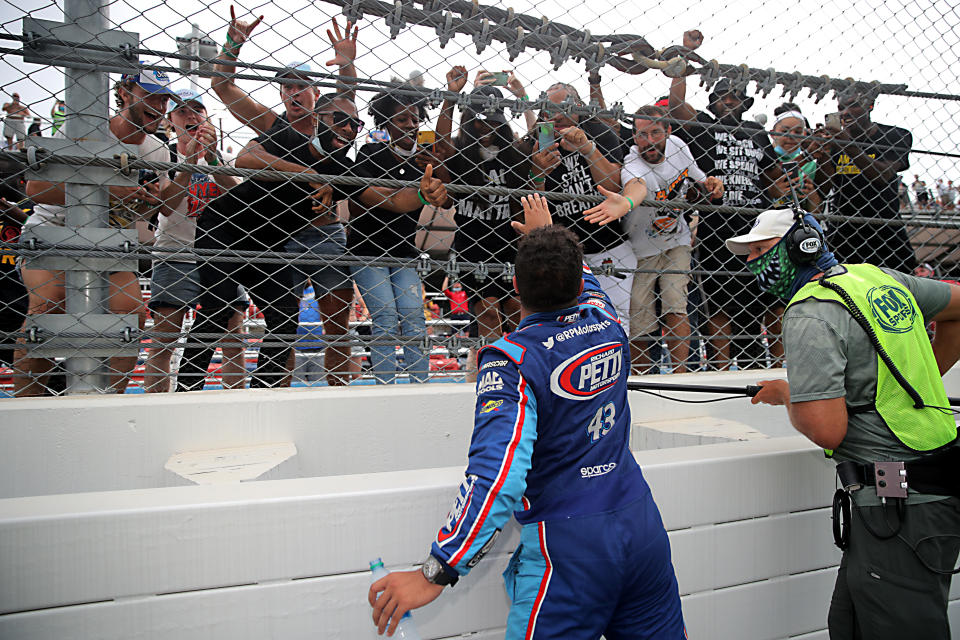Bubba Wallace could be just what NASCAR needs, despite the ugly circumstances around his rise to fame
Less than 24 hours after NASCAR reported a noose had been discovered in his garage stall, Bubba Wallace marched across Talladega International Speedway to greet a group of fans screaming their support.
Pressed up against a fence was a mostly African American group, apparently attending their first NASCAR event ever. Wallace had just finished 14th, fuel issues impacting his chance at a storybook victory, but this was still a moment for prideful celebration.
A pre-race outpouring from his fellow drivers and team members had captured the nation’s attention. It was enough for Wallace, the sport’s only Black driver, to break down in tears. Now it was all smiles, though, with a new cheering section to boot.
“This is probably the most badass moment,” Wallace said about the crowd.
“First time right here?” he asked.
Yes, they shouted.
“From Atlanta?”
Again, a yes.
“That is so cool,” Wallace said. “The sport is changing.”
It is. It has to.
No one wanted it this way. No one wanted racist symbols to overwhelm another race. No one wanted Wallace to have to deal with the shock and horror of being informed by NASCAR’s president about the noose.
Yet it happened. And, in ways that those who want to anchor the sport to the past must abhor, it may have pushed it forward in unimaginable ways.
“Sorry I’m not wearing my mask,” Wallace said on Fox, “but I wanted to show whoever it was that you’re not going to take away my smile and I’m going to keep on going.”

FBI investigators said late Tuesday that no federal charges would be filed in the case, as the noose had been in the garage stall since the fall of 2019. Still, the moment had happened.
It is no secret that NASCAR is, and has been, desperate to find a young, breakout star that can excite the masses and draw in a new generation of fans.
The recent (or pending) retirements of Dale Earnhardt Jr., Jeff Gordon, Jimmie Johnson and Tony Stewart, among others, have left a vacuum that has yet to be filled. Ratings continue to sag. Ticket sales (pre-coronavirus) have been slow.
There is promise, notably Chase Elliott, but for the last few years NASCAR has struggled to identify and promote the next generation to connect with a far more diverse America. That includes Wallace, the 26-year-old now in his third full season at the Cup level.
If something good can come out of something terrible, then this is it — the emergence on a national scale of a thoughtful, likable, charismatic driver who is uniquely positioned to drag a sport through a world that is changing so rapidly even cars designed to go 200 miles an hour can’t keep up.
His interaction with the fans was broadcast live on national television, to a weeknight audience (weather delayed the event a day), at least some of whom had tuned in out of curiosity only to see a thrilling finish, the sport at its finest and a driver of great dignity and strength. His profile is set to soar, both within and beyond the racing world.
Will those fans stick around? Will they tune in this weekend at Pocono? Will they consider attending a (Confederate flag-free) race now? Who knows?
Over the long haul, Wallace will need to win to make a real difference. He hasn’t found victory lane in his career but there is plenty of promise (four top-15 finishes in the last five starts), especially if he can move to a better team than Richard Petty Motorsports.
“Bubba needs to have a racing platform to get him to the front and keep him at the front,” said Bill Lester, an African American driver from 1999-2007. “Money buys speed. If you don’t have the right money, the right resources, you don’t win.”
And if he won, Lester said the impact will be massive.
“When Tiger [Woods] showed up in golf as a winner, when Serena and Venus [Williams] showed up in tennis as winners, the Black community came out in droves,” Lester noted. “The Black community came out and supported them.”

Tiger and Serena are impossibly high bars to reach. It also wasn’t just the Black community that embraced them. They brought out new fans of all kinds, drawn to their personalities and style as well as their games. Wallace could do the same, even if he’s just in the mix most weeks.
NASCAR needs it. Among a segment of its most loyal customers, the banning of the Confederate flag is not popular. At Talladega, the flag was flown in protest overhead via a plane and in a pickup truck parade outside the track.
Some of these people will choose the flag over the sport and never watch again. Others will rebel against Wallace becoming a star at all.
NASCAR can’t cling to them. It can’t cling to the past and hope to survive in the future. It needs a spark to draw in those who might get hooked on this wild soap opera of a sport. A love of fast cars transcends everything. Age. Race. Geography. Or it should.
Here on a weekend of old ugliness came a fresh face that racing desperately needs. Neither NASCAR nor Bubba Wallace asked for this, at least not this way.
Here he comes though. Here’s Bubba Wallace.
More from Yahoo Sports:
